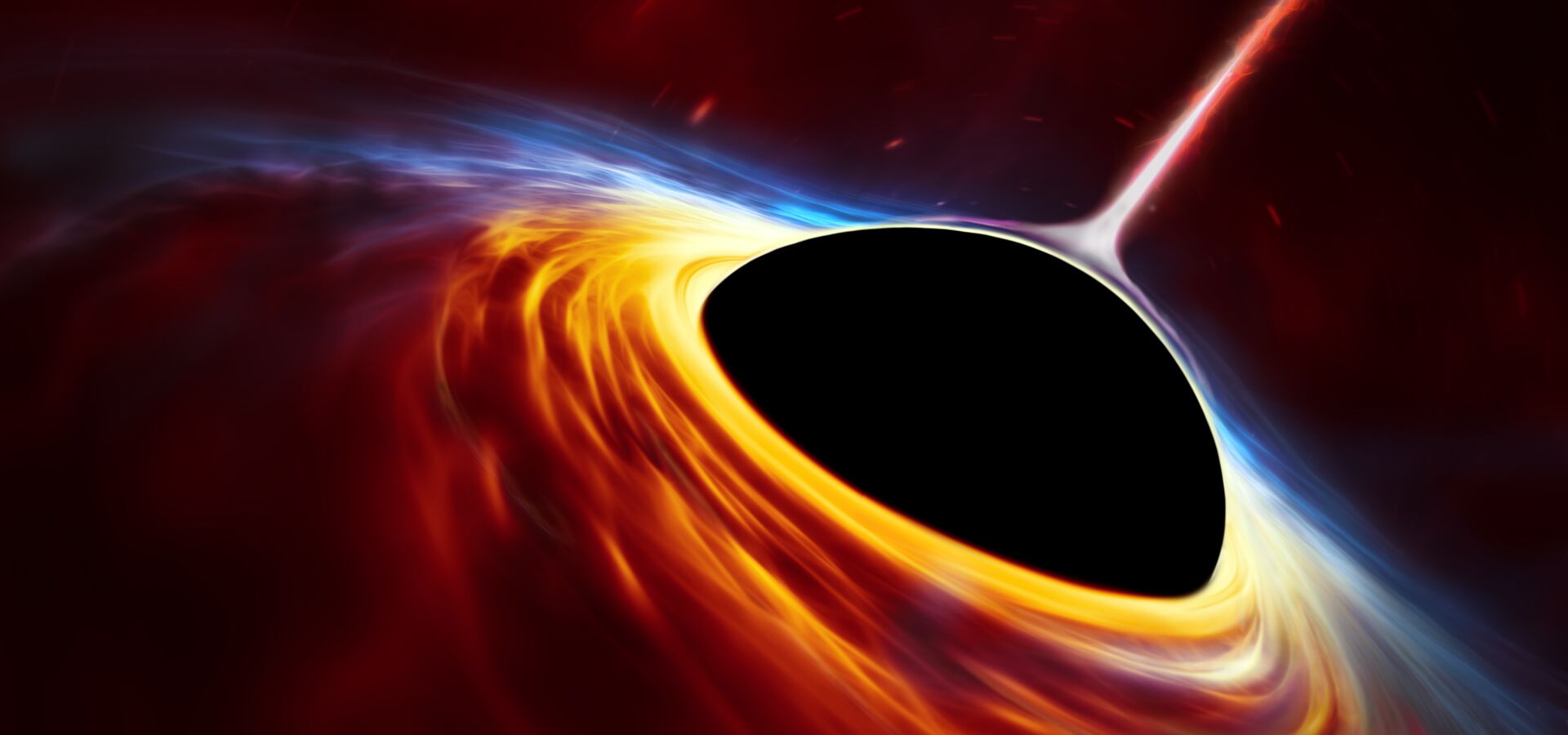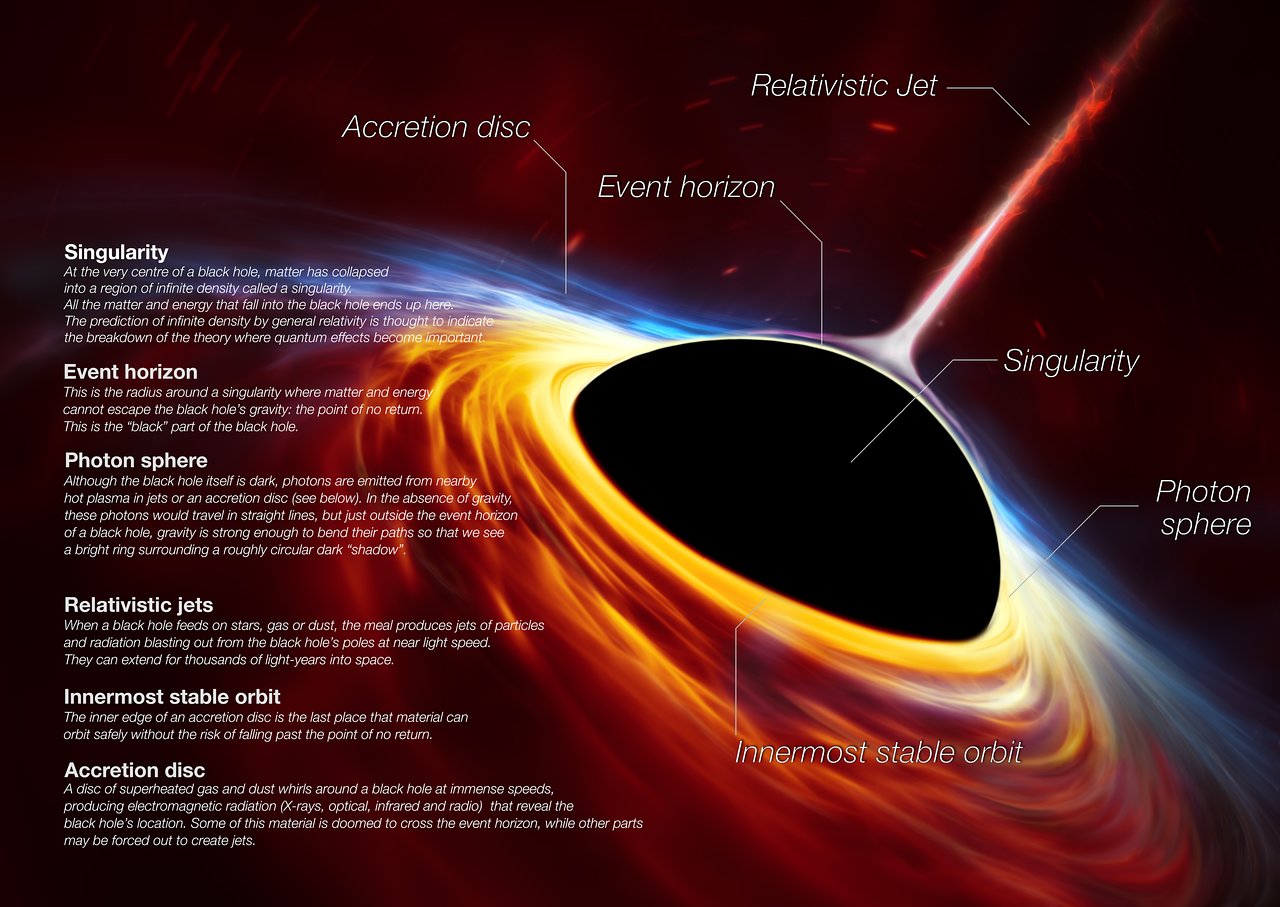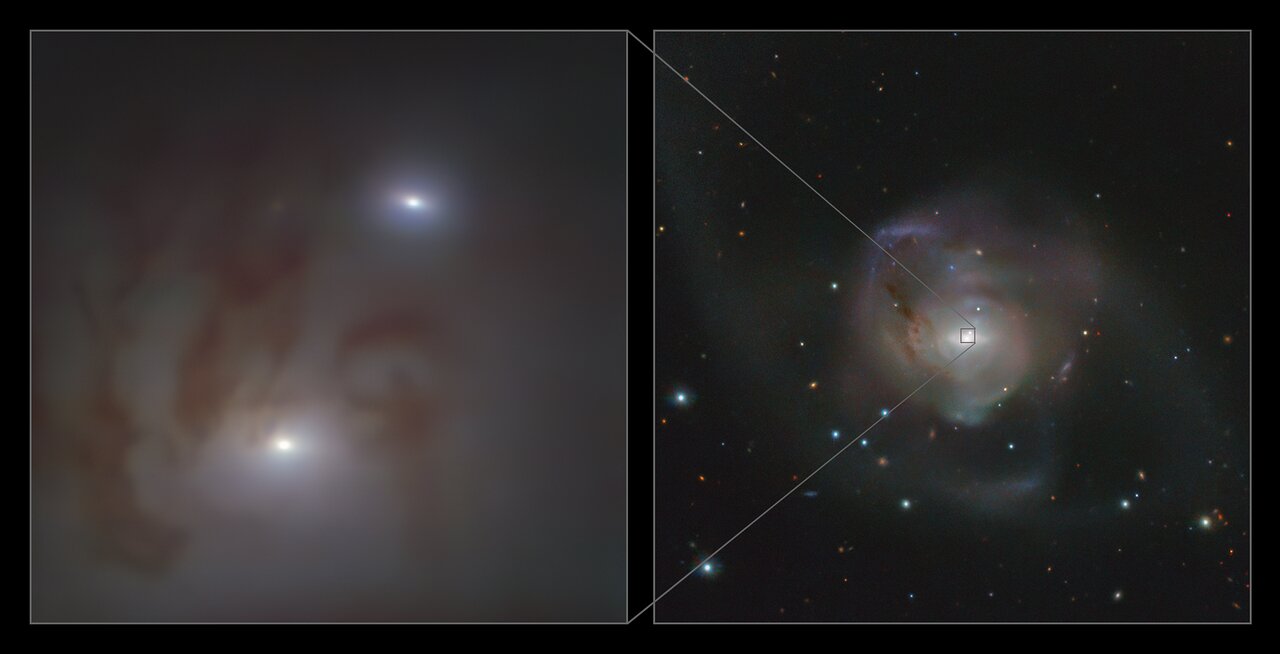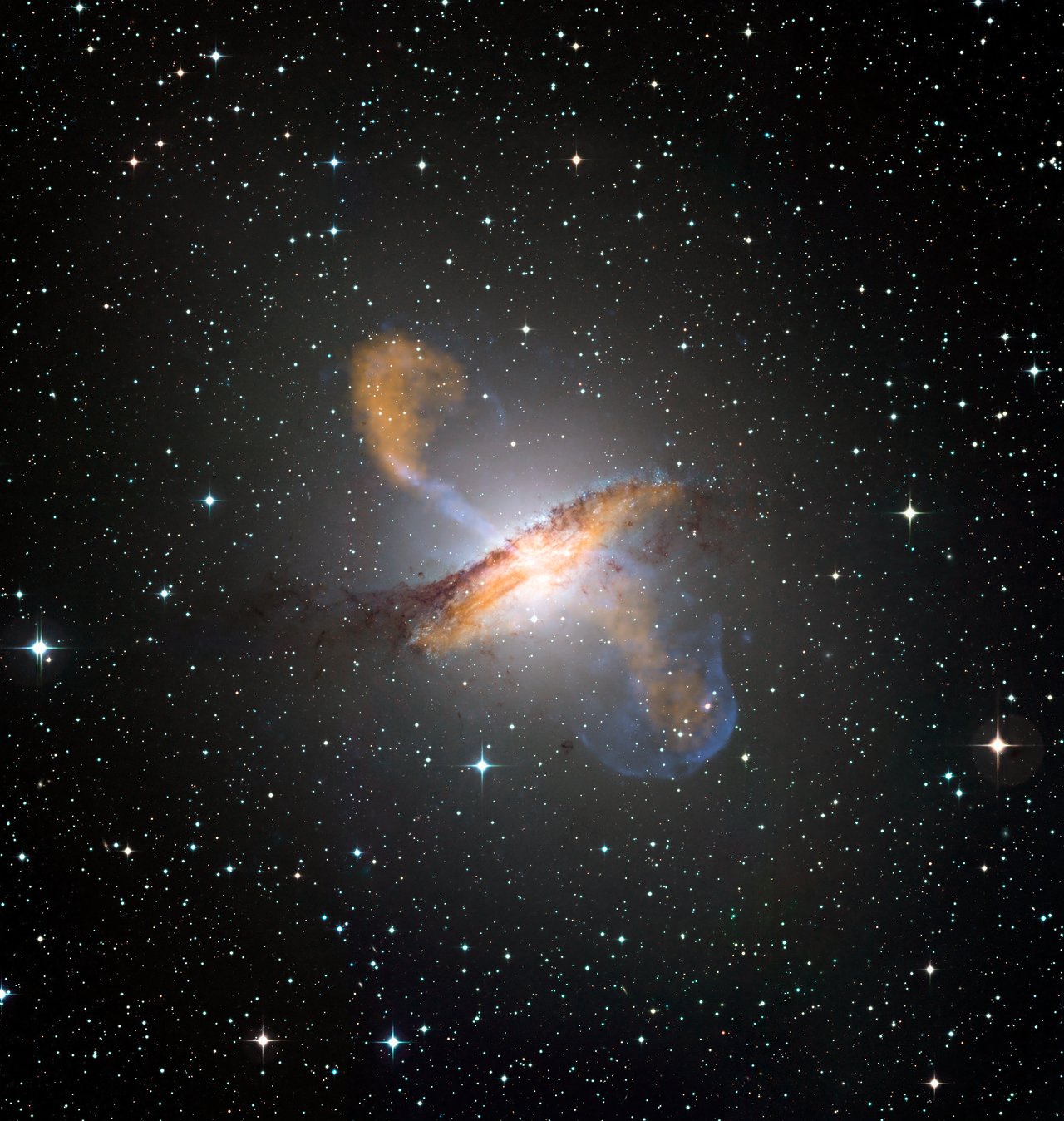- The anatomy of a black hole
- Formation theories for supermassive black holes
- How supermassive black holes power active galactic nuclei and quasars
Unless you have access to an extremely powerful particle accelerator, you can’t create a black hole. But for a second, let’s imagine you could… How would you go about forming, feeding, and nurturing a supermassive black hole of your own? This handy guide will teach you everything you need to know!
Before We Begin: What is a Black Hole?
Illustrations of black holes in the media tend to show a mysterious, dark sphere, vacuuming any matter that dares to stray too close — but how accurate is this portrayal? Before we begin, let’s examine the anatomy of a black hole to understand exactly how dangerous this new hobby may be.
In large objects, like stars, there is always a crushing inwards pressure from gravity that aims to collapse the object in on itself, and this pressure grows stronger the denser an object gets. When matter is crushed compactly enough, gravity becomes a runaway effect, unstoppably collapsing the object into an increasingly tighter space until it reaches an infinite density: a singularity. This is the heart of a black hole.
In this region of space, the gravitational strength is so great that even light cannot escape it. The point of no return — the distance where rescue is no longer possible — is called the event horizon.
But step back, beyond what we call the ‘innermost stable orbit’, and the risk of falling is gone. Objects at this distance orbit the black hole the same way they would a star of the same mass — but with a lack of heat or light. Not that this makes this environment any safer: as we’ll see later, black holes are often surrounded by deadly radiation…
This inability to release or reflect light is the origin of both the ‘black’ hole name, and their traditional depiction as a mysterious black sphere vacuuming the cosmos. To an observing telescope, they are invisible except for the distortive effect they have on the cosmos around them — like a magnifying lens floating through space.
If this was the only sign of a black hole, they would be very difficult to detect. Luckily, black holes interact with their environment to produce many other signals of their presence, and these are especially noticeable in the case of supermassive black holes. Often, they are surrounded by rings of dust and gas caught in their gravitational orbit called accretion discs, which we’ll discuss further later in this guide.
Not all black holes are alike. Some are just a few times more massive than the Sun, but others are billions of times more massive, So: how can you get a black hole that big?
Step 1a: Growing a Supermassive Black Hole
For the best quality supermassive black hole, consider an organic, home-grown option. Astronomers believe supermassive black holes may originate from ‘seed’ black holes in the early eras of the Universe that eventually grew to incredible sizes. But how these early seeds formed and just how massive they were remains uncertain.
These seeds would have started much smaller than the monsters we see today, born perhaps from the collapse of massive stars. Stellar-mass black holes still form this way today, and comprise most of the black holes in the Universe. Just recently, ESO’s Very Large Telescope (VLT) helped verify the most massive stellar black hole in the Milky Way, a bulky 33 times the mass of our Sun. The very first stars that formed in the early Universe are thought to be much more massive than the ones we see today, and could have left behind more massive black holes after they died.
There are potentially millions of these stellar-mass black holes living alongside us in the Milky Way galaxy. But for one of them to grow into a supermassive black hole, they would need access to a lot of food — meaning, they needed to be placed into a dusty galaxy. Astronomers believe the lucky black holes that found themselves in these types of galaxies in the early Universe were able to gobble up vast reservoirs of cold hydrogen gas, rapidly gaining mass and eventually inflating to the immense sizes of the supermassive giants we see today. One of these reservoirs was even observed around an early supermassive black hole by ESO’s VLT in 2019.
When a black hole ‘eats’ matter in this way, it’s called accretion. But accretion is a very slow way for a stellar black hole to become supermassive, and some evidence suggests that accretion alone could not account for the masses of some supermassive black holes we see in the timespan of the Universe. So, how else can black holes grow?
In the nuclei of galaxies, pairs of black holes can orbit each other tightly, slowly losing energy, shrinking their orbit until they eventually become close enough to merge. In one of the most extreme and energetic events in the Universe, the two black holes dance around each other at speeds close to the speed of light, combining into one remnant black hole. This typically takes place between stellar mass black holes, but in some cases, entire galaxies with black holes at their cores can merge, leaving one chaotic galaxy with an enormous supermassive black hole at its centre.
While stellar mass black holes may have been the seeds that later grew into more massive black holes, astronomers also think that gigantic clouds of gas in the early Universe could have collapsed directly into a black hole without forming a star first. If you want to try this alternative method to grow a black hole, you will need to gather several hundred thousand solar masses worth of gas.
Once your black hole has grown to a few hundreds of thousands times the mass of the Sun, you’re ready to move on to step two: lighting up your black hole. If for any reason you are unable to grow a supermassive black hole at home, check your local Universe for ready-made options.
Step 1b: Hunting down a Black Hole
There are many impressive spectacles a supermassive black hole can display, making them easy to find in the local Universe. One, that we mentioned earlier, is their glowing accretion discs.
These accretion discs are flattened clouds of gas orbiting the black hole, which – close to the centre – are flung at such high speeds around the black hole that they become superheated and glow in many wavelengths of light. Incredibly, when the Event Horizon Telescope collaboration was able to take the first images of black holes, these were responsible for the iconic blazing, dusty rings seen in the images.
There have also been observations of supermassive black holes devouring nearby stars, resulting in incredible explosions as the stars release their last light. ESO telescopes were able to witness one of these rare displays in 2016, and again in 2020. A similar event observed by the VLT in 2022 showed rare bursts of extreme plasma jets, expelling the leftovers of the stellar meal: a supermassive belch.
Some supermassive black holes go beyond these spectacles to become some of the brightest objects in the Universe —- in the next section, we’ll discuss how to get your own supermassive black hole this bright.
Step 2: Let There Be Light!
While all supermassive black holes are impressive, only some of them power immensely bright active galactic nuclei, or AGN. Even the mammoth at the centre of our own galaxy, Sagittarius A*, doesn’t qualify. In this step, we detail how to get your supermassive black hole to be amongst the biggest and brightest in the Universe.
Astronomers use AGN to describe supermassive black holes that are especially greedy, gorging on immense amounts of dust from their accretion disks and sometimes spitting out incredible blasts, called jets, at near-light speed. A stunning image of an AGN, Centaurus A, and its jets was captured by APEX in 2009.
One model suggests that depending on how the AGN is orientated with respect to Earth, the same supermassive black hole can look much brighter or dimmer. The accretion disc sitting around the spherical black hole takes on a similar silhouette to Saturn and its rings. To ensure your own AGN appears more luminous, you should orient the black hole so that as little of the accretion disc obscures it from an observer on Earth as possible. Astronomers refer to AGN that face towards Earth in this way as quasars.
In 2024, ESO’s VLT made the incredible observation of a quasar that shattered expectations — not only was it the most luminous quasar ever discovered, but the brightest object ever observed in the Universe. Powering it is a behemoth supermassive black hole eating the equivalent of the Sun in mass every single day, making it the fastest-growing black hole seen to date.
Even better, if your supermassive black hole releases a jet, ensure the jet is pointed directly towards Earth. (We recommend having a parent or trusted adult supervise this step.) If done correctly, the blazing plasma itself will not reach astronomers, but the observation will likely be brighter than anything they’ve seen before. AGN in this specific orientation are upgraded from quasars to blazars, and can theoretically be seen from billions of light-years away.
Step 3: Profit?
Supermassive black holes are some of the most interesting objects in the Universe. There is so much left to learn about how they interact with their surrounding galaxies, influence the formation of stars around them, and how they grew so incredibly massive — especially since the cosmos seems to lack black holes in the tremendous mass gap between stellar and supermassive.
ESO’s Extremely Large Telescope hopes to uncover the complex relationships between supermassive black holes and central star formation in galaxies, as well as tracing back the formation of supermassive black holes in the early Universe, when it sees first light later this decade. Until then, enjoy your homemade supermassive black hole!
Biography Louisa Spillman
Louisa is originally from a small countryside town in England. She has completed an MSci in Physics with a Master’s project on gravitational waves, but more recently has taken time to travel to pretty places, take up photography, and read old fantasy novels. Louisa is passionate about making science communication as enjoyable as possible for both the public and herself, and has adored astrophysics ever since she realised that staring into space could be a career.





